

What is Operant Conditioning. What Is Operant Conditioning and How Does It Work? Operant conditioning, sometimes referred to as instrumental conditioning, is a method of learning that employs rewards and punishments for behavior.
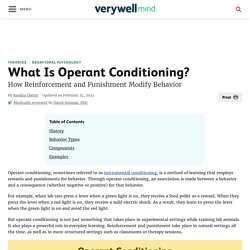
Through operant conditioning, an association is made between a behavior and a consequence (whether negative or positive) for that behavior.1 For example, when lab rats press a lever when a green light is on, they receive a food pellet as a reward. When they press the lever when a red light is on, they receive a mild electric shock. As a result, they learn to press the lever when the green light is on and avoid the red light. What is Reinforcement? What Is Reinforcement in Operant Conditioning? What is Positive Reinforcement? Positive Reinforcement and Operant Conditioning.
In operant conditioning, positive reinforcement involves the addition of a reinforcing stimulus following a behavior that makes it more likely that the behavior will occur again in the future.
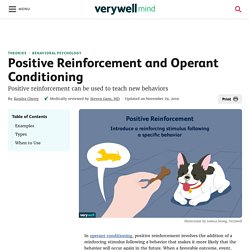
When a favorable outcome, event, or reward occurs after an action, that particular response or behavior will be strengthened. One of the easiest ways to remember positive reinforcement is to think of it as something being added. By thinking of it in these terms, you may find it easier to identify real-world examples of positive reinforcement. Sometimes positive reinforcement occurs quite naturally. For example, when you hold the door open for someone you might receive praise and a thank you. What is Negative Reinforcement? Negative Reinforcement and Operant Conditioning. How Reinforcement Schedules Work. Operant conditioning is a learning process in which new behaviors are acquired and modified through their association with consequences.

Reinforcing a behavior increases the likelihood it will occur again in the future while punishing a behavior decreases the likelihood that it will be repeated. In operant conditioning, schedules of reinforcement are an important component of the learning process. When and how often we reinforce a behavior can have a dramatic impact on the strength and rate of the response. EVALUATING THE SEPARATE AND COMBINED EFFECTS OF POSITIVE AND NEGATIVE REINFORCEMENT ON TASK COMPLIANCE. What is Punishment? The Study of Punishment in Psychology. What is Positive Punishment? Positive Punishment and Operant Conditioning. Positive punishment is a concept used in B.F.

Skinner's theory of operant conditioning. How exactly does the positive punishment process work? The goal of any type of punishment is to decrease the behavior that it follows. In the case of positive punishment, it involves presenting an unfavorable outcome or event following an undesirable behavior. When the subject performs an unwanted action, some type of negative outcome is purposefully applied.
The concept of positive punishment can be difficult to remember, especially because it seems like a contradiction. Examples You may be surprised to notice examples of positive punishment in your day-to-day life. Because you're late to work one morning, you drive over the speed limit through a school zone. What is Negative Punishment? Negative Punishment. Punishment is an important concept used in the theory of Operant conditioning, whose main goal is to decrease the rate of certain undesired behavior from occurring again.
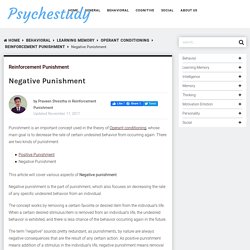
There are two kinds of punishment This article will cover various aspects of Negative punishment. Negative punishment is the part of punishment, which also focuses on decreasing the rate of any specific undesired behavior from an individual. The concept works by removing a certain favorite or desired item from the individual’s life. Improving Road Safety through Deterrence-Based Initiatives. Untitled. Reinforcement and Punishment. Strengthening Deterrence Against Irresponsible Driving. Road Safety Tips. A safe road journey cannot be taken for granted!
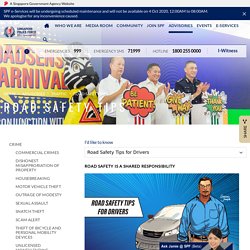
Like Gracious Joseph, remember to always exercise patience and graciousness. Stay alert, drive carefully and follow traffic rules, signs, and signals. Follow these safe-driving tips and habits to enhance your experience on the roads, and make your journeys more safe and pleasant. Never drink and drive. Never get behind the wheel when you’re tired. Maintain your vehicle regularly to minimise the chances of an accident due to mechanical failure. Always check your blind spot – avoid changing lanes at bends. Road conditions differ and road hazards may appear unexpectedly. Always keep in mind the existence of road hazards Keep a lookout for smaller or vulnerable road users, such as cyclists or power-assisted bicycle users, and pedestrians like children and elderly, who may dash across the road. Forum: Various initiatives in place to encourage safe driving, Forum News.
Traffic Police And Motorist Announce Strategic Partnership To Foster Safer Roads In Singapore. SINGAPORE, 8th June 2020 – Motorist, Singapore’s leading automotive platform, today announced a strategic partnership with the Traffic Police to cultivate a safer driving culture in Singapore.
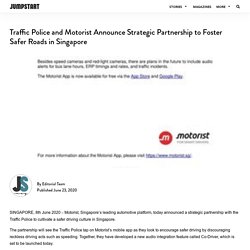
The partnership will see the Traffic Police tap on Motorist’s mobile app as they look to encourage safer driving by discouraging reckless driving acts such as speeding. Together, they have developed a new audio integration feature called Co-Driver, which is set to be launched today. This feature, found exclusively in the Motorist App, will incorporate data from the Traffic Police on the locations of speed and red-light cameras.
By simply activating Co-Driver on the Motorist App, drivers will receive real time audio alerts on these cameras, as well as reminders to drive safer and more courteously. While there are a number of other apps that provide audio cues on red-light and traffic cameras, Co-Driver is the only one that includes red zones for Police Speed Laser Camera (PSLC). Traffic Fines in Singapore - LTA, URA, HDB, TP and ERP. When you own a car, traffic wardens are your worst enemy and roadblocks send shivers down your spine – after all, there’s nothing worse than getting traffic fines in Singapore.

Motorists get pulled over - for doing good. When Mr Lim Kan Seng's Toyota Previa was pulled over by the Traffic Police along New Upper Changi Road yesterday morning, he panicked a little. Mr Lim, 50, a hawker, thought he might be in for a summons, but what he received instead were a zebra plush toy and $40 worth of petrol vouchers. "I thought I had done something wrong... but the police said they saw me giving way to another driver, and wanted to commend me," he said. "I had just turned left into the main road when another car was trying to cut into my lane from the right, so I let him pass. " Mr Lim was among seven motorists who were pulled over on the roads yesterday for displaying good driving habits, as part of a nine-hour island-wide "Spot the Conscientious Motorists" operation conducted by the police. Since the programme started in October 2013, 391 motorists have been identified and rewarded.
Motorists get a commendation certificate, in addition to the road safety mascot toy and vouchers. adrianl@sph.com.sg.